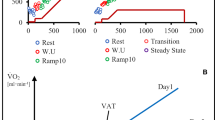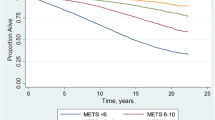Abstract
Background and aims: The purpose of this study was to compare the effects of exercise habituation (3–32 years, mean 13.2 years) on physical vitality among five different groups. Methods: One hundred and two independent, community-dwelling elderly Japanese men, aged 64.6±6.6 years, were recruited as subjects. The vital age test battery consisted of various coronary heart disease risk factors and physical fitness elements. Results: The results of analysis of variance revealed that vital age as an index of physical vitality was youngest in joggers (47.9 yr, N=18), intermediate in trekkers (55.8 yr, N=20) and walkers (59.1 yr, N=18), and oldest (69.6 yr, N=20) in patients with ischemic heart disease (IHD). The difference between chronological age and vital age was approximately 15 years (p<0.05) in joggers, and 8 years (p<0.05) in trekkers and walkers. The vital age of sedentary persons (N=26) was only 1.9 years (NS) younger than their chronological age, which was similar to the difference (vital age of 64.1±8.5 yr vs chronological age of 65.7±5.4 yr) previously observed in similarly aged exercising IHD patients. Conclusions: These results indicate that exercise habituation significantly affects the overall health status of most individuals, irrespective of mode of exercise. Among the three modes of exercise, jogging may be most beneficial. Furthermore, regularly exercising coronary patients may have physical vitality similar to that of sedentary men.
Similar content being viewed by others
References
Tanaka K, Matsuura Y, Nakadomo F, Nakamura E. Assessment of vital age of Japanese women by principal component analysis. Jpn J Phys Educ 1990a; 35: 121–31.
Chodzko-Zajko WJ. The physiology of aging: structural changes and functional consequences. Quest 1996; 48: 311–29.
Paffenbarger RS, Hyde RT, Wing AL, Lee IM, Jung DL, Kamperet JR. The association of changes in physical activity level and other life-style characteristics with mortality among men. N Engl J Med 1993; 328: 538–45.
Blair SN, Kohl HW, Barlow HW, Paffenbarger RS, Gibbons LW, Macera CA. Changes in physical fitness and all-cause mortality. J Am Med Assoc 1995; 273: 1093–8.
Tanaka K, Takeda M, Hayakawa Y, et al. Aerobic exercise lowers biological age of patients with coronary heart disease or hypertension. In Harris S, Suominen H, Era P, Harris W, Eds. Physical activity, aging and sports. Vol. III: Towards healthy aging - International perspectives - Part 1. Physiological and biomedical aspects. New York: Center for the Study of Aging, 1994: 235–45.
Tanaka K. Development of aging index for middle-aged and older adults. In Matsuura Y, Ed. Suuri Tairyokugalku. Tokyo: Asakura Shoten, 1993: 76–83.
Tanaka K, Yoshimura T, Maeda K, Watanabe Y, Hiyama T. Validity of CHD risk factor-dependent “vital age” as an index of health and aging status. J Jap Atheroscl Soc 1991; 219: 303–10.
Nho H, Tanaka K, Kim HS, Watanabe Y, Hiyama T. Exercise training in female patients with a family history of hypertension. Eur J Appl Physiol 1998; 78: 1–6.
Clark JW. The aging dimension: a factorial analysis of individual differences with age on psychological and physiological measurements. J Gerontol 1960; 15: 183–7.
Nakamura K, Miyao K, Ozeki T. Assessment of biological age by principal component analysis. Mech Ageing Dev 1988; 46: 1–18.
Friedewald WT, Levy RI, Fredrickson DS. Estimation of the concentration low-density lipoprotein cholesterol in plasma, without use of the preparative ultracentrifuge. Clin Chem 1970; 18: 499–502.
Wannamethee G, Shaper AG. Haematocrit: Relationships with blood lipids, blood pressure and other cardiovascular risk factors. Thromb Haemos 1994; 72: 58–64.
Tanaka K, Takeshima N, Kato T, Niihata S, Ueda K. Critical determinants of endurance performance in middle-aged and elderly endurance runners with heterogeneous training habits. Eur J Appl Physiol 1990b; 59: 443–9.
Tanaka K, Shigematsu R, Nakagaichi M, Kim H, Takeshima N. The relationship between functional fitness and coronary heart disease risk factors in older Japanese adults. J Aging Phys Activ 2000; 7: 162–74.
Morris JN, Heady JA, Raffle PAB, Roberts CG, Parks JW. Coronary heart disease and physical activity of work. Lancet 1953; 265: 1053–7, 1111–20.
Bijnen FC, Caspersen CJ, Mosterd WL. Physical inactivity as a risk factor for coronary heart disease: A WHO and International Society and Federation of Cardiology position statement. Bull WHO 1994; 72: 1–4.
Fletcher GF, Blair SN, Blumenthal J, et al. Statement on exercise. Benefits and recommendations for physical activity programs for all Americans. A statement for health professionals by the Committee on Exercise and Cardiac Rehabilitation of the Council on Clinical Cardiology. American Heart Association. Circulation 1992; 86: 340–4.
Blair SN, Kohl HW III, Paffenbarger RS Jr, Clark DG, Cooper KH, Gibbons LW. Physical fitness and all-cause mortality: A prospective study on healthy men and women. J Am Med Assoc 1989; 262: 2395–401.
Morris JN, Clayton DG, Everitt M, Semmence AA, Burgess EH. Exercise in leisure time: Coronary attack and death rates. Br Heart J 1990; 63: 325–34.
Lee IM, Hsieh CC, Paffenbarger RS Jr. Exercise intensity and longevity in men: The Harvard Alumni health study. J Am Med Assoc 1995; 273: 1179–84.
Expert Panel on Detection, Evaluation, and Treatment of High Blood Cholesterol in Adults. Summary of the Second Report of the National Cholesterol Education Program (NCEP) Expert Panel on Detection, Evaluation, and Treatment of High Blood Cholesterol in Adults (Adult Treatment Panel). J Am Med Assoc 1993; 269: 3015–23.
Pate RR, Pratt M, Blair SN. Physical activity and public health: a recommendation from the Centers for Disease Control and Prevention and the American College of Sports Medicine. J Am Med Assoc 1995; 273: 402–7.
Nelson ME, Fiatarone MA, Morganti CN, Trice RA, Greenberg RA, Evans WJ. Effects of high-intensity strength training on multiple risk factors for osteoporotic fractures: a randomized controlled trial. J Am Med Assoc 1994; 272: 1909–14.
Taaffe DR, Pruitt L, Pyka G, Guido D, Marcus R. Comparative effects of high and low intensity resistance training on thigh muscle strength, fiber area and tissue composition in elderly women. Clin Physiol 1996; 16: 381–92.
Stefanick ML, Wood PD. Physical activity, lipid and lipoprotein metabolism, and lipid transport. In Bouchard C, Shephard RJ, Stephens T, Eds. Physical activity, fitness and health: International proceedings and consensus statement. Champaign, IL: Human Kinetics, 1994: 417–31.
Stefanick ML. Exercise and weight control. In Holloszy JO, Ed. Exercise and sport sciences reviews. ACSM Series, no. 21. Baltimore: Williams & Wilkins, 1993: 363–96.
Lakka TA, Venalinen JM, Rauramaa R, Salonen R, Tuomilehto J, Salonen JT. Relation of leisure-time physical activity and car-diorespiratory fitness to the risk of acute myocardial infarction. N Engl J Med 1994; 330: 1549–54.
Harridge S, Magnusson G, Saltin B. Life-long endurance-trained elderly men have high aerobic power, but have similar muscle strength to non-active elderly men. Aging Clin Exp Res 1997; 9: 80–7.
Siscivuck DS, Weiss NS, Fletcher RH, Lasky T. The incidence of primary cardiac arrest during vigorous exercise. N Engl J Med 1984; 311: 874–7.
Author information
Authors and Affiliations
Corresponding author
Rights and permissions
About this article
Cite this article
Tanaka, K., Sakai, T., Nakamura, Y. et al. Health benefits associated with exercise habituation in older Japanese men. Aging Clin Exp Res 16, 53–59 (2004). https://doi.org/10.1007/BF03324533
Received:
Accepted:
Published:
Issue Date:
DOI: https://doi.org/10.1007/BF03324533




